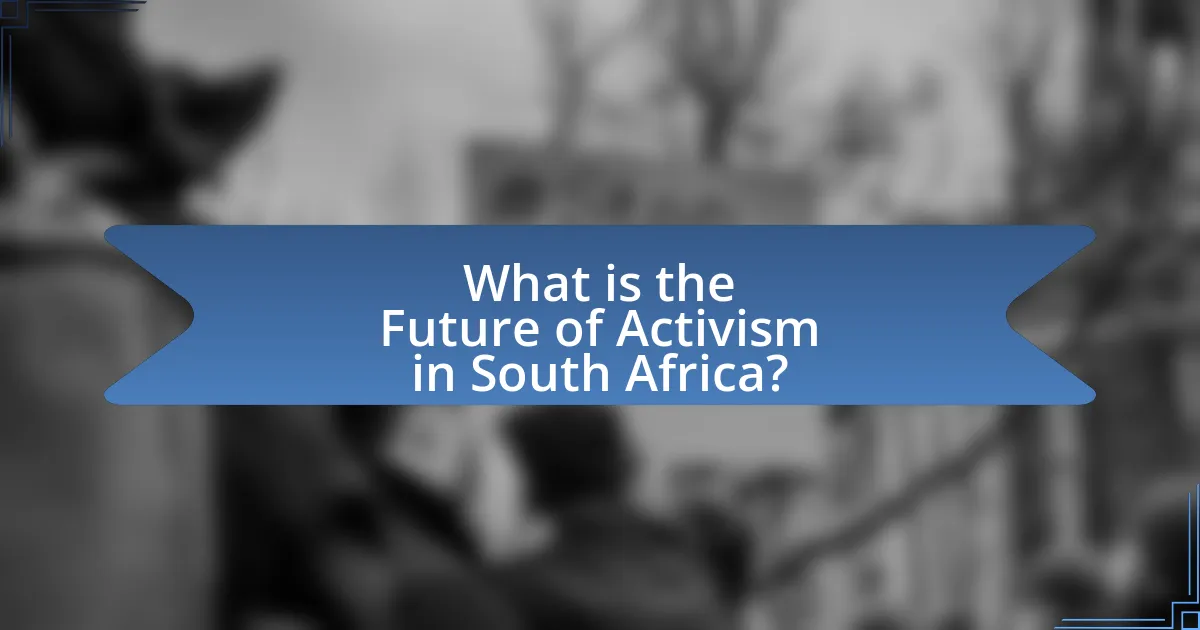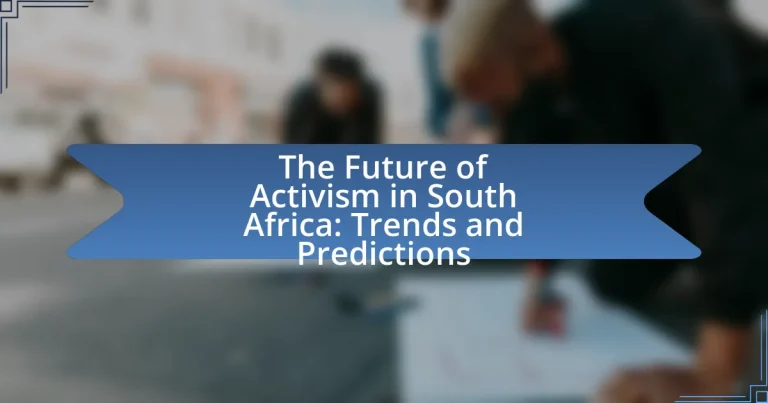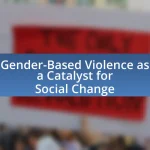The article examines the future of activism in South Africa, highlighting trends such as increased digital engagement and a focus on intersectional social issues. It traces the evolution of activism from the anti-apartheid movement to contemporary campaigns addressing economic inequality, gender rights, and environmental concerns. Key historical events, socio-political factors, and current trends are analyzed, revealing how digital platforms are reshaping mobilization efforts. The article also discusses the challenges activists face, the role of youth in driving change, and strategies for effective collaboration and engagement in future activism.

What is the Future of Activism in South Africa?
The future of activism in South Africa is likely to be characterized by increased digital engagement and a focus on intersectional issues. Activists are increasingly utilizing social media platforms to mobilize support and raise awareness, as evidenced by movements like #FeesMustFall and #BlackLivesMatter gaining traction online. Additionally, the rise of youth-led initiatives indicates a shift towards addressing a broader range of social justice issues, including climate change, gender equality, and economic inequality. This evolution reflects a growing recognition of the interconnectedness of various social issues, suggesting that future activism will be more inclusive and collaborative.
How has activism evolved in South Africa over the years?
Activism in South Africa has evolved significantly from the anti-apartheid movement to contemporary social justice campaigns. Initially, activism was primarily focused on dismantling apartheid, with organizations like the African National Congress leading mass mobilizations and protests, culminating in the end of apartheid in 1994. Following this, activism diversified to address issues such as economic inequality, gender-based violence, and environmental concerns, with movements like #FeesMustFall and #TotalShutDown gaining prominence in the 2010s. These movements utilized social media to mobilize support and raise awareness, reflecting a shift towards digital activism. The evolution of activism in South Africa demonstrates a transition from a singular focus on political liberation to a broader agenda encompassing various social issues, driven by grassroots organizations and youth engagement.
What historical events have shaped current activism trends?
The historical events that have shaped current activism trends include the anti-apartheid movement, the Soweto Uprising of 1976, and the post-apartheid constitutional reforms. The anti-apartheid movement mobilized widespread national and international support against racial segregation, leading to significant changes in South Africa’s political landscape. The Soweto Uprising, where students protested against the imposition of Afrikaans in schools, highlighted the power of youth activism and galvanized further resistance against oppressive policies. Additionally, the establishment of a democratic constitution in 1996, which enshrined human rights and freedoms, has provided a legal framework that empowers contemporary activists to advocate for social justice, equality, and environmental issues. These events collectively inform the strategies and focus areas of current activism in South Africa.
How do socio-political factors influence activism in South Africa?
Socio-political factors significantly influence activism in South Africa by shaping the priorities, strategies, and mobilization efforts of activists. The legacy of apartheid continues to affect social inequalities, prompting movements that address issues such as land reform, economic justice, and access to basic services. For instance, the rise of the Fees Must Fall movement in 2015 highlighted the intersection of education and economic disparities, demonstrating how socio-political contexts can galvanize youth activism. Additionally, the political landscape, characterized by corruption and governance challenges, fuels public discontent and drives collective action, as seen in the widespread protests against state capture and corruption in recent years. These factors create a dynamic environment where activism evolves in response to ongoing socio-political challenges, reflecting the urgent needs and aspirations of marginalized communities.
What are the current trends in South African activism?
Current trends in South African activism include a strong focus on social justice, environmental issues, and digital activism. Social justice movements, such as those advocating for gender equality and anti-racism, have gained momentum, particularly following the global Black Lives Matter movement. Environmental activism has also surged, driven by concerns over climate change and land rights, with groups like Extinction Rebellion South Africa mobilizing for action. Additionally, digital platforms have become crucial for organizing protests and raising awareness, as seen in campaigns like #FeesMustFall, which highlighted the need for affordable education. These trends reflect a growing intersectionality in activism, where various social issues are addressed collectively, demonstrating the evolving landscape of civic engagement in South Africa.
Which social issues are driving activism today?
Social issues driving activism today include climate change, racial inequality, gender rights, and economic justice. Climate change activism has surged, with movements like Fridays for Future highlighting the urgency of environmental action. Racial inequality remains a critical issue, as seen in the global Black Lives Matter movement, which addresses systemic racism and police brutality. Gender rights activism, particularly around issues like reproductive rights and gender-based violence, has gained momentum, reflecting a growing demand for equality and safety. Economic justice is also a focal point, with movements advocating for fair wages and workers’ rights, particularly in the context of rising living costs and economic disparities. These issues are interconnected and reflect broader societal demands for justice and equity.
How are digital platforms changing the landscape of activism?
Digital platforms are transforming the landscape of activism by enabling rapid communication, broadening outreach, and facilitating grassroots mobilization. These platforms allow activists to share information instantly, organize events, and engage with a global audience, significantly increasing the visibility of social issues. For instance, the #FeesMustFall movement in South Africa utilized social media to mobilize students against rising tuition fees, demonstrating how digital tools can amplify local concerns to a national and international audience. Additionally, research from the Pew Research Center indicates that 69% of adults in South Africa use social media, highlighting the potential for these platforms to influence public opinion and drive social change effectively.
What predictions can be made about the future of activism in South Africa?
Activism in South Africa is predicted to become increasingly digital and decentralized, driven by the rise of social media platforms and mobile technology. This shift allows for broader participation and engagement among diverse demographics, particularly the youth, who are more adept at using these tools for organizing and advocacy. Historical trends indicate that movements like #FeesMustFall and #BlackLivesMatter have successfully mobilized support through online channels, demonstrating the effectiveness of digital activism in addressing social issues. Furthermore, as socio-economic disparities persist, activism is likely to focus more on economic justice, environmental concerns, and human rights, reflecting the evolving priorities of the population.
How might technology further influence activism in the coming years?
Technology will significantly enhance activism in the coming years by providing new platforms for communication and mobilization. Social media, for instance, has already proven effective in organizing protests and spreading awareness, as seen during the #FeesMustFall movement in South Africa, which utilized platforms like Twitter and Facebook to rally support and share information rapidly. Additionally, advancements in data analytics and artificial intelligence will enable activists to better understand public sentiment and target their campaigns more effectively, as evidenced by the use of data-driven strategies in recent electoral campaigns globally. Furthermore, the rise of blockchain technology may offer secure methods for fundraising and ensuring transparency in donations, which can bolster trust in activist organizations. Overall, these technological advancements will create more efficient, transparent, and impactful activism in South Africa and beyond.
What role will youth play in shaping future activism?
Youth will play a pivotal role in shaping future activism by driving social change through digital platforms and grassroots movements. Their proficiency with technology enables them to mobilize quickly, raise awareness, and engage a global audience, as evidenced by movements like #FeesMustFall in South Africa, which highlighted educational inequalities and garnered international support. Furthermore, studies indicate that younger generations prioritize social justice issues, such as climate change and racial equality, influencing the agenda of activism and policy-making. This generational shift is crucial, as youth-led initiatives often challenge traditional structures and advocate for innovative solutions, ensuring that activism remains relevant and impactful in addressing contemporary societal challenges.
What challenges does activism face in South Africa?
Activism in South Africa faces significant challenges, including government repression, social inequality, and internal divisions among activist groups. Government repression manifests through legal restrictions, police violence, and intimidation tactics aimed at silencing dissent. For instance, the South African Police Service has been criticized for its heavy-handed approach to protests, leading to violent clashes. Social inequality, exacerbated by high unemployment rates and poverty, often hampers collective action, as marginalized communities struggle to engage in activism while addressing basic needs. Additionally, internal divisions among various activist groups can lead to fragmentation, reducing the overall effectiveness of movements. These challenges collectively hinder the progress and impact of activism in the country.
How do governmental policies impact activist movements?
Governmental policies significantly impact activist movements by shaping the legal and social environment in which these movements operate. For instance, policies that promote freedom of speech and assembly empower activists to organize and express their views without fear of repression, as seen in South Africa’s post-apartheid era where the Constitution guarantees these rights. Conversely, restrictive policies, such as laws limiting protests or criminalizing dissent, can stifle activism and lead to increased repression, evidenced by the government’s response to movements like Fees Must Fall, which faced police violence and legal challenges. Thus, the nature of governmental policies directly influences the effectiveness and sustainability of activist movements.
What are the risks associated with activism in the current climate?
Activism in the current climate poses several risks, including legal repercussions, physical harm, and social backlash. Legal risks arise from potential arrests or charges related to protests or civil disobedience, as seen in various countries where laws have been enacted to limit protest activities. Physical harm is a significant concern, as activists may face violence from opposing groups or law enforcement, evidenced by incidents during protests in South Africa where activists have been injured. Social backlash can manifest as public vilification or ostracism, particularly in polarized environments where activism challenges prevailing norms or government policies. These risks highlight the precarious nature of engaging in activism today.
How can activists effectively mobilize support in the future?
Activists can effectively mobilize support in the future by leveraging digital platforms and data analytics to engage and organize communities. The rise of social media has transformed activism, allowing for rapid dissemination of information and mobilization of supporters, as evidenced by movements like #FeesMustFall in South Africa, which utilized Twitter and Facebook to rally students against tuition increases. Additionally, employing data analytics can help activists identify key demographics and tailor their messaging, increasing the likelihood of engagement and support. Research indicates that targeted campaigns can significantly enhance participation rates, demonstrating the effectiveness of these strategies in contemporary activism.
What strategies can be employed to engage a broader audience?
To engage a broader audience, activists in South Africa can utilize social media platforms effectively. Research indicates that 90% of South Africans use social media, making it a vital tool for outreach and engagement. By creating compelling content that resonates with diverse demographics, activists can foster community involvement and raise awareness about social issues. Additionally, collaborating with influencers who have established followings can amplify messages and reach wider audiences. Engaging in community events and partnerships with local organizations can also enhance visibility and participation, as these strategies create a sense of belonging and shared purpose among various groups.
How can collaboration between different activist groups enhance impact?
Collaboration between different activist groups can enhance impact by pooling resources, knowledge, and networks to address complex social issues more effectively. When diverse groups unite, they can leverage their unique strengths, such as specialized expertise or grassroots connections, to create a more comprehensive approach to activism. For instance, the collaboration between environmental and social justice organizations in South Africa has led to more robust campaigns that address both ecological sustainability and community rights, resulting in greater public awareness and policy influence. This synergy not only amplifies their voices but also increases the likelihood of achieving shared goals, as evidenced by successful coalitions that have led to significant legislative changes in the country.
What best practices should activists adopt for future success?
Activists should adopt strategic coalition-building as a best practice for future success. By forming alliances with diverse groups, activists can amplify their voices and resources, leading to more significant impact. For instance, the #FeesMustFall movement in South Africa successfully united students, labor unions, and civil society organizations, resulting in policy changes regarding university fees. This demonstrates that collaboration enhances visibility and effectiveness in advocacy efforts. Additionally, leveraging digital platforms for outreach and engagement is crucial, as seen in the global response to climate change activism, where social media campaigns mobilized millions. These practices not only foster inclusivity but also create a robust support network essential for sustained activism.


